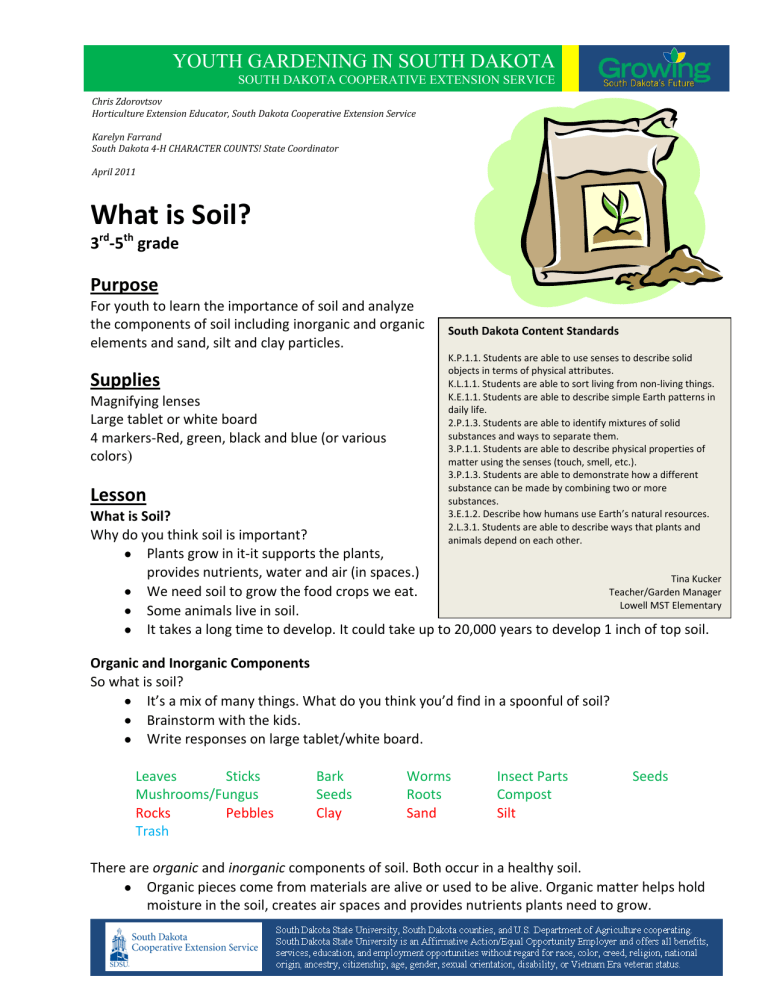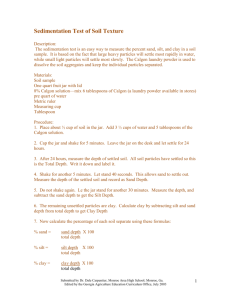What is Soil?

YOUTH GARDENING IN SOUTH DAKOTA
SOUTH DAKOTA COOPERATIVE EXTENSION SERVICE
Chris Zdorovtsov
Horticulture Extension Educator, South Dakota Cooperative Extension Service
Karelyn Farrand
South Dakota 4-H CHARACTER COUNTS! State Coordinator
April 2011
What is Soil?
3 rd
-5 th
grade
Purpose
For youth to learn the importance of soil and analyze the components of soil including inorganic and organic elements and sand, silt and clay particles.
Supplies
Lesson
Magnifying lenses
Large tablet or white board
4 markers-Red, green, black and blue (or various colors )
South Dakota Content Standards
K.P.1.1. Students are able to use senses to describe solid objects in terms of physical attributes.
K.L.1.1. Students are able to sort living from non-living things.
K.E.1.1. Students are able to describe simple Earth patterns in daily life.
2.P.1.3. Students are able to identify mixtures of solid substances and ways to separate them.
3.P.1.1. Students are able to describe physical properties of matter using the senses (touch, smell, etc.).
3.P.1.3. Students are able to demonstrate how a different substance can be made by combining two or more substances.
What is Soil?
Organic and Inorganic Components
3.E.1.2. Describe how humans use Earth’s natural resources.
2.L.3.1. Students are able to describe ways that plants and
Why do you think soil is important? animals depend on each other.
Plants grow in it-it supports the plants, provides nutrients, water and air (in spaces.)
We need soil to grow the food crops we eat.
Tina Kucker
Teacher/Garden Manager
Some animals live in soil.
Lowell MST Elementary
Sioux Falls, SD
It takes a long time to develop. It could take up to 20,000 years to develop 1 inch of top soil.
So what is soil?
It’s a mix of many things. What do you think you’d find in a spoonful of soil?
Brainstorm with the kids.
Write responses on large tablet/white board. Tina Kucker
Teacher/Garden Manager
Lowell MST Elementary
Leaves Sticks Bark Worms Insect Parts
Mushrooms/Fungus Seeds Roots Compost
Rocks
Trash
Pebbles Clay Sand Silt
There are organic and inorganic components of soil. Both occur in a healthy soil.
Organic pieces come from materials are alive or used to be alive. Organic matter helps hold moisture in the soil, creates air spaces and provides nutrients plants need to grow.
YOUTH GARDENING IN SOUTH DAKOTA
SOUTH DAKOTA COOPERATIVE EXTENSION SERVICE o Underline the organic responses with a green marker.
Inorganic is a term for particles that have worn from rocks. These particles are grouped based on their size into three categories- Sand , silt and clay .
o These particles have never been alive and provide minerals the plants need to grow. o Sand, silt and clay give the soil its structure. These particles are mixed in different ratios depending on the location. The different combinations are important because they will have different properties. o Underline the inorganic responses with a red marker.
Underline other items that would not naturally occur in soil such as trash in blue.
Allow youth to collect soil from the garden and then examine the soil with magnifying lenses. Have them separate the materials into two separate areas, organic & inorganic.
Soil Particles
Soil has three particle sizes: Sand, Silt & Clay.
Sand: The largest particle size and has large air spaces. It drains water well. It may dry out too quickly and not allow plants to get enough water. It does not hold minerals well. o Have youth put a pinch of sand in their palm. Have them feel the sand with their finger and describe it. They should indicate that it feels gritty.
Silt: The middle-sized particle with a darker color. It hold water better than sand, but may not drain well. It has medium-size air spaces. It can hold minerals effectively. o Have youth put a pinch of silt (or flour to represent silt) in their palm. Have them feel the silt with their finger and describe it. They should indicate that it feels silky or powdery.
Clay: The smallest particle and creates small air spaces. It has poor water drainage and plants may grow poorly because it is too wet. It can hold minerals effectively.
Have youth mix a drop of water with the flour in their palm to represent clay. Have them feel the water/flour mix with their finger and describe it. They should indicate that it feels sticky. Have them use hand wipe to clean hands.
Review Key Vocabulary Words ( In italic)
Journal Time
In your journal g ive an example of an organic and inorganic soil component. Then list the three inorganic soil participles from largest to smallest (Sand, silt, clay)
Sources:
Down to Earth Publication 4HCCs BU-07714, 2002, 33 by Bob Williamson & Ellen Smoak, Extension
Specialists,, NC A&T State University and , & Junior Master Gardener Teacher/Leader Guide, Level 1 , B-
6083, 1999, pg 33
Leaders/Helpers Guide, Garden Group Activity, Purdue University. Cooperative Extension Service, pg. 9
Math in the Garden, University of California Botanical Garden and Lawrence Hall of Science, Berkeley,
CA, 2006, pg 140-141
YOUTH GARDENING IN SOUTH DAKOTA
SOUTH DAKOTA COOPERATIVE EXTENSION SERVICE
Planting Seeds of Character
What is a Person of Character?
Purpose
Students will learn what qualities make up a person of character.
Supplies
Six popsicle sticks for every student; Markers; Flipchart paper
Activity
Ask the students what qualities does a person of character possess? Record their answers on flipchart paper, news print or white board. Ex. Trustworthiness, Respect, Responsibility, Fairness, Caring and
Citizenship. These qualities form a solid foundation for a person to make good decisions. Ask the students what would happen if they only had one of these qualities when they were trying to make a decision? Would you have a very solid foundation to make a decision? At this time write down one of the qualities they have stated on a popsicle stick. Ask for a volunteer to come up and see if they can break the popsicle stick. They will probably have no trouble in breaking the stick. Then add another quality to another popsicle stick and see if a student can break two popsicle sticks. They may or may not be able to. Then add another value and see if a student can break three popsicle sticks. Repeat this process until you have the 6 qualities of a person of character that were mentioned above.
Questions:
After the first popsicle stick ask if a person possesses only one quality would that be a firm foundation to make their decisions on. The answer is no.
Continue asking the above question until you get all six qualities, Trustworthiness, Respect,
Responsibility, Fairness, Caring and Citizenship.
After you have all six qualities ask the students would this be a firm foundation to base your decisions? Is this stack of six qualities easy to break?
How long does it take to develop a firm foundation of character? Just like soil takes 20,000 years to make an inch, it takes a person his/her whole life to keep developing to be a person of character. A person will continue to be challenged with difficult decisions and each decision you can choose to handle it as a person of character or not.
Summary:
A person of character possesses the qualities of trustworthiness, respect, responsibility, fairness, caring and citizenship. When a person of character is faced with making a decision they will ask themselves the following question. This decision I am about to make will it make me a trustworthy, respectful, responsible, fair, caring and a good citizen? If I can answer yes to each of the qualities then the decision I am about to make is a good one. If I answer no to any of the qualities then I had better stop and see if this is the best decision for me or if there is another option.







